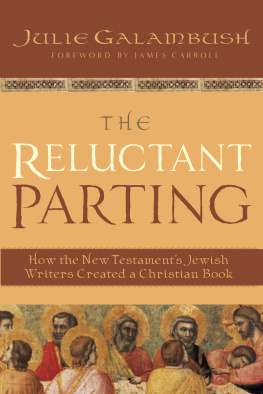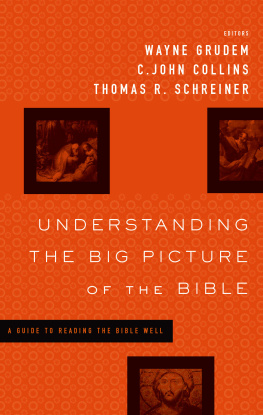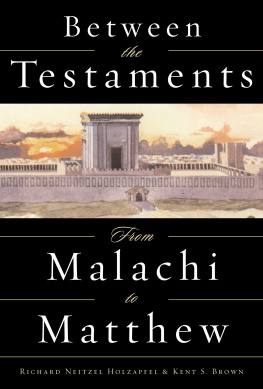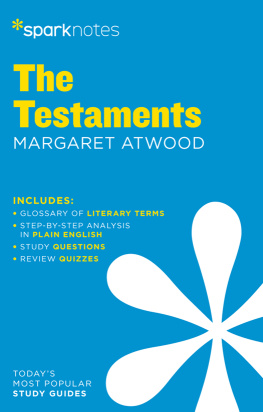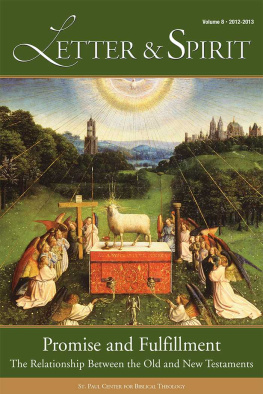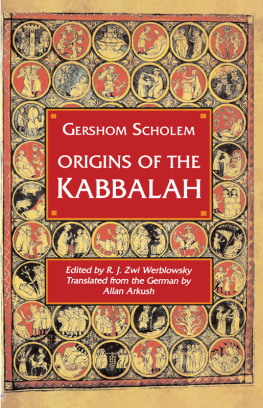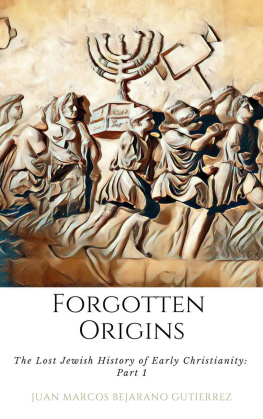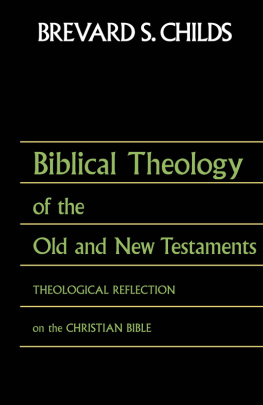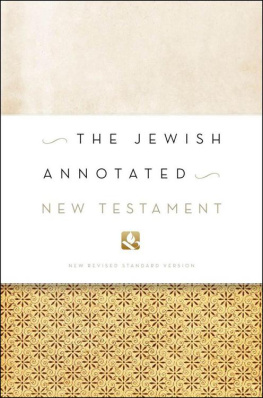Julie Galambush - The Reluctant Parting: How the New Testaments Jewish Writers Created a Christian Book
Here you can read online Julie Galambush - The Reluctant Parting: How the New Testaments Jewish Writers Created a Christian Book full text of the book (entire story) in english for free. Download pdf and epub, get meaning, cover and reviews about this ebook. year: 2011, publisher: HarperCollins, genre: Religion. Description of the work, (preface) as well as reviews are available. Best literature library LitArk.com created for fans of good reading and offers a wide selection of genres:
Romance novel
Science fiction
Adventure
Detective
Science
History
Home and family
Prose
Art
Politics
Computer
Non-fiction
Religion
Business
Children
Humor
Choose a favorite category and find really read worthwhile books. Enjoy immersion in the world of imagination, feel the emotions of the characters or learn something new for yourself, make an fascinating discovery.
- Book:The Reluctant Parting: How the New Testaments Jewish Writers Created a Christian Book
- Author:
- Publisher:HarperCollins
- Genre:
- Year:2011
- Rating:3 / 5
- Favourites:Add to favourites
- Your mark:
- 60
- 1
- 2
- 3
- 4
- 5
The Reluctant Parting: How the New Testaments Jewish Writers Created a Christian Book: summary, description and annotation
We offer to read an annotation, description, summary or preface (depends on what the author of the book "The Reluctant Parting: How the New Testaments Jewish Writers Created a Christian Book" wrote himself). If you haven't found the necessary information about the book — write in the comments, we will try to find it.
Discover the New Testaments Forgotten Jewish Origins
Julie Galambush: author's other books
Who wrote The Reluctant Parting: How the New Testaments Jewish Writers Created a Christian Book? Find out the surname, the name of the author of the book and a list of all author's works by series.
The Reluctant Parting: How the New Testaments Jewish Writers Created a Christian Book — read online for free the complete book (whole text) full work
Below is the text of the book, divided by pages. System saving the place of the last page read, allows you to conveniently read the book "The Reluctant Parting: How the New Testaments Jewish Writers Created a Christian Book" online for free, without having to search again every time where you left off. Put a bookmark, and you can go to the page where you finished reading at any time.
Font size:
Interval:
Bookmark:
THE
RELUCTANT
PARTING
H OW THE N EW T ESTAMENTS
J EWISH W RITERS
C REATED A C HRISTIAN BOOK
JULIE GALAMBUSH

For Rob and Aaron
Contents
W hen I was a child, my favorite part of the comics page was the cartoon puzzle featuring a drawing of an ordinary scenesay, a family on a picnic. The challenge consisted in the directive to, say, Find the hidden man. Turning the page this way and that, one examined the picnic sceneMom unpacking the wicker basket, Dick and Jane playing ball, Dad at the cookout grill, Spot nipping at the ball, clouds in the sky, the spreading leaves of a tree. Suddenly, snap! All at once, a tree branch appeared as an eyebrow, the thicket of clouds as a head of hair, Dad with his spatula had become the line of a delicate nose. With an unwilled shift in focus, the picnic scene was gone, replaced in its entirety by the face of a friendly-looking man.
Julie Galambush accomplishes a shift in perspective like that with this book. She takes the most familiar literature in the Christian worldtherefore, perhaps, in Western civilizationand by turning it this way and that, enables a wholly new picture to emerge from the well-known lines. The hidden man who snaps into unprecedented focus through the readings of New Testament texts offered here is Jesusbut Jesus as rarely seen by either Christians or Jews, Jesus as a Jew, a figure who preached nothing but the God of Israel until (or even after) the day he died.
The books central concern is less with Jesus, however, than with the communities of his first followers, and there, too, Galambush accomplishes a breathtaking shift in focus, providing a far more complex and far richerview of early Christian impulses than is ordinarily available. In addition to a hidden man, there is a hidden communal realitynot a church yet, perhaps no longer a synagogue, but not a single reality in any case. Part church, part synagogue, part Jewish sect, part Gentile associationall unfolding in a period of massive cultural and religious mutation. The multiplicity of responses to the evangelion of Jesus by first-century Jews and Gentiles, ranging from radical apocalyptic fervor to enraged rejection, and everything in between, is itself a forgotten wonder of the Christian story, much as the varieties of Jewish self-understanding in the era, dramatized by twentieth-century discoveries at Qumran, are also only now being understood.
Some of Jesus early followers were fully and permanently Jewish conservative Palestinian Jews, but also worldly, hellenized Jews of the diaspora. Such Jews recognized Jesus as messiah and understood him within the context of expressly Jewish expectation. Some of these Jewish Christians were radical opponents of the Roman empire at a time of increasing military pressure against resisting Jews, and some were resigned to the Roman sway, if not friendly to it. Some early followers were Gentiles, including religiously inclined pagans (so-called God-fearers) who brought to the Jesus sect a prior interest ineven reverence forJudaism. There were regional differences and class differences, all leading to differences in emphasis and interpretation as the Jesus tradition began to jell around certain stories, sayings, memories, philosophical categories, and midrashic inventions. A sense of such lively distinctions among the varieties of responses to Jesus was mainly lost across the decades and centuries, as texts were canonized and as orthodoxy was defined and enforced.
One of this books accomplishments is the way in which Julie Galambush, in a marvel of close and original reading, identifies and explicates these various paradoxical, if not contradictory, themes within the New Testament texts themselves. She reads with a concern to enter wherever possible into the point of view of those who wrote these texts and first read them. That alone marks her project off from the more traditional method of reading texts in the light of later orthodox interpretations.
The gospels and epistles, together with Acts and Revelation, represent multiple visions of the significance of Jesus, some of which are in stark tension, even conflict, with one another. The great shift in focus occursand here I write as a Christianwhen the reader is enabled to perceive that tension as part of the internal dynamic of the early Christian reality itselftension, that is, within the broad circle of those who accepted the messiahship of Jesus, instead of tension, as it is usually recalled, between those who followed Jesus and those who rejected him. This is the crucial insight.
The modern crime of racial anti-Semitism was prepared for by the Christian anti-Judaism that spanned two millennia, beginning with the churchs early understanding of itself as the bipolar opposite of Judaism. It is commonly noted now, even outside scholarly circles, that the conflict between Jesus and the Jews that marks so much of the New Testament narrative reflects a conflict not of Jesus time but of the subsequent period, a generation or more later, when those who followed Jesus were in conflict with those who rejected him. The argument is fierce (and the language is polemical) because, just as the gospels, derived from oral traditions, began to be written down, the entire world of Judaism was thrown into crisis by the Roman destruction of the temple in 70 C.E. What was it to be a Jew without the temple? Some Jews answered by saying that Jesus was the New Temple, and others by saying that to be a Jew was to be centered on the imagined Temple of Oral Torah. In this more sophisticated reading, the gospels and other New Testament texts are understood as embodying one side of an argument between Christ-affirming Jews (and their Gentile communicants) and Christ-rejecting Jews.
But in Galambushs reading, we see through to a deeper and richer level of complexity. What if the argument reflected in the Jesus-versus-the-Jews dynamic of the texts is not onlyor even mainlybetween Christ-affirming Jews and Christ-rejecting Jews, but between one group of Christ-affirming Jews and another? What if the much maligned group the Jews, who are made explicitly responsible for the blood of Jesus in Matthew, or who are literally demonized in John, includes Jews who honor Jesus as messiah but disagree over what, precisely, his messiahship means? To take the most obvious example of such tension, the dispute over whether Gentile converts to the Jesus movement had to be circumcisedhad, that is, to become Jews in order to become Christianshas been relegated in Christian memory to the status of a fairly minor argument that was more or less efficiently resolved by Saint Paul (who died before the gospels were written), but what if that argument was definitive and long-standing, wrenching Christ-following communities across decades, and territory. What if the Jews who wanted to attack Paul in Jerusalem, early in the New Testament period, were Christian Jews who objected to his apparent denigrations of Torah? What if the Jews who cast Johannine Christians out of the synagogue, late in the New Testament period, were Christ-following Jews who took offense at Johns application of Logos imagery to Jesusor at Johns apparent readiness to call this Jesus-Logos God? What if the New Testament, in sum, is less concerned with judgingor condemningthat large majority of Jews who had nothing to do with Jesus or his followers, than with refuting those within the nascent church who wanted only to continue regarding it as the synagogue? What we would have here, in such a case, is less the church against the synagogue than the church against itself.
Why does this matter? As long as the New Testament is read as an essential Christian condemnation of Jews and Judaism for the rejection of Christ as, first, the Jewish messiah and, then, the Word of God who was with God and who was God, Jews and Judaism will be at risk. The misremembering of Christian origins has been lethal, and if it continues, it will be lethal again. The momentous achievements of post-Holocaust Jewish-Christian dialogue, in which contempt and suspicion were replaced by civility and respect, are not enough. The source of Christian contempt for Jews must be uprooted. A subtle but transforming shift in focus must occur in the way Christians perceive their foundational texts. That can in no way be accomplished by a rewriting of the texts, an expunging of the foul anti-Jewish polemic, nor can it be accomplished by pretending the anti-Jewish slanders are not there.
Next pageFont size:
Interval:
Bookmark:
Similar books «The Reluctant Parting: How the New Testaments Jewish Writers Created a Christian Book»
Look at similar books to The Reluctant Parting: How the New Testaments Jewish Writers Created a Christian Book. We have selected literature similar in name and meaning in the hope of providing readers with more options to find new, interesting, not yet read works.
Discussion, reviews of the book The Reluctant Parting: How the New Testaments Jewish Writers Created a Christian Book and just readers' own opinions. Leave your comments, write what you think about the work, its meaning or the main characters. Specify what exactly you liked and what you didn't like, and why you think so.

